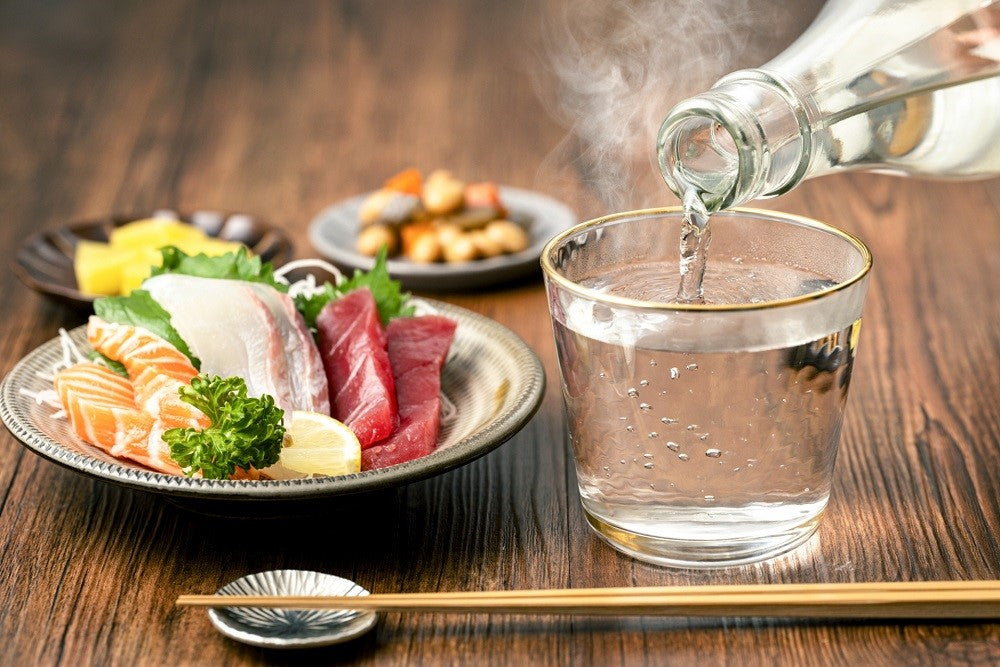
Shochu is a distilled liquor produced in Japan since ancient times and has been widely consumed by the masses along with sake.
Curious about the difference between shochu and sake? Let’s dive in to know more!
What is Shochu?
Shochu is a type of distilled liquor, a clear, colorless alcohol made from rice or potatoes. It is believed that distillation technology was first introduced to Japan in the mid Muromachi period (15th century), and the name shochu first appeared in the late Muromachi period (mid 16th century). On the other hand, sake is often made in colder regions in Japan, while shochu is mostly produced in the Kyushu (warmer) region.
Basic Differences between Shochu and Sake
The first and most important difference is that sake is a brewed alcoholic beverage, meaning that it is made by fermenting ingredients such as rice and barley. Shochu, on the other hand, is distilled alcohol, which is made by heating fermented alcohol and utilizing the difference in boiling points between water and alcohol.
First of all, the alcohol content (ALC) of sake and shochu differs greatly, partly due to differences in production methods. For example, when it comes to distilled shochu, it has a higher alcohol content than sake. The Liquor Tax Law requires that sake have an alcohol content of less than 22%, and most common sake has an alcohol content of around 15-16%.
On the other hand, when freshly distilled, it is not uncommon for shochu to reach 35% ALC or more. However, because the Liquor Tax Law limits the alcohol content, the ALC in shochu is adjusted to 20-25% before being made available in the market.
Differences in Ingredients

Another major difference between sake and shochu is their ingredients. While "rice" is used for sake, there are three basic types of raw materials for shochu.
Mugi Shochu- Ingredients: Barley
- Features:
Smooth on the palate and easy to drink. Its clean and crisp flavor can be appreciated even by shochu beginners.
With an alcohol content of 20-25%, it has no peculiar aroma and is popular on the rocks or with oolong. - Representative Production Area: Nagasaki Prefecture
- Ingredients: Sweet Potato
- Features:
It is characterized by sweetness and mellowness particular to sweet potato, and its flavor varies depending on: the variety of sweet potato used, its place of origin, the type of malted rice used, and the production method.
There are those with a strong taste that bring out the full flavor of the sweet potato, and those that are fruity and refreshing.
Today, there are more than 40 types of sweet potatoes that can be used as ingredients. - Representative Production Area: Kagoshima, Miyazaki Prefecture
- Ingredients: Rice
- Features:
It is characterized by a light and refreshing taste, while still retaining the flavor and sweetness derived from rice.
While potato shochu and barley shochu sometimes use different ingredients for koji than the main ingredients, rice shochu is made from rice and rice koji, or 100% rice. - Representative Production Area: Kumamoto Prefecture
In addition, shochu is classified into "Korui" and "Otsurui" according to the definition of the Liquor Tax Law.
Korui is defined as shochu that fulfills the prerequisites of being made with "continuous distillation" and "less than 35% alcohol by volume,” while Otsurui is defined as shochu that is being made with "pot distillation" and having "less than 45% alcohol by volume”.
The ingredients for Korui shochu is a fermented liquid made from sake lees or waste molasses. On the other hand, Otsurui shochu is made mainly from barley, rice, and sweet potatoes.
|
|
Korui |
Otsurui |
|
Distillation Method |
Renzokushiki Joryu |
Tanshiki Joryu |
|
Alcohol by Volume |
Less than 35% |
Less than 45% |
|
Ingredients |
Fermentation liquid made from Sakekasu (sake lees) and waste molasses |
Rice, wheat, buckwheat and other grains, potatoes, sake lees, brown sugar, and 49 other items designated by the Commissioner of the National Tax Administration Agency |
Difference in Carbohydrates Content
Whereas sake contains carbohydrates, shochu contains none at all. Therefore, it is a better choice for those who are restricting carbohydrates or dieting.
Below is a list of the carbohydrate content per 100 ml of common alcoholic beverages.
| Sugar content / per 100ml of alcohol | |
| Japanese Sake | 3.6g |
| Beer | 3.1g |
| Red Wine | 1.5g |
| Whisky | 0g |
| Shochu | 0g |
Differences in Drinking Methods
Sake is generally drunk straight. Another characteristic of sake is that it can be enjoyed at different temperatures, such as chilled, at room temperature, or heated. Shochu, on the other hand, has a higher alcohol content, so it is generally drunk on the rocks with ice, or mixed with water, hot water, carbonated water, or pickled plums, rather than straight.

Summary
Both being Japan’s signature alcoholic beverages, sake and shochu can be easily confused as more or less the same thing. But as the above description suggests, they are indeed very different - at the same time without one being better or worse than the other. We hope that learning about their differences can allow you to better appreciate their unique characteristics. So, which drink are you going to order tonight?

